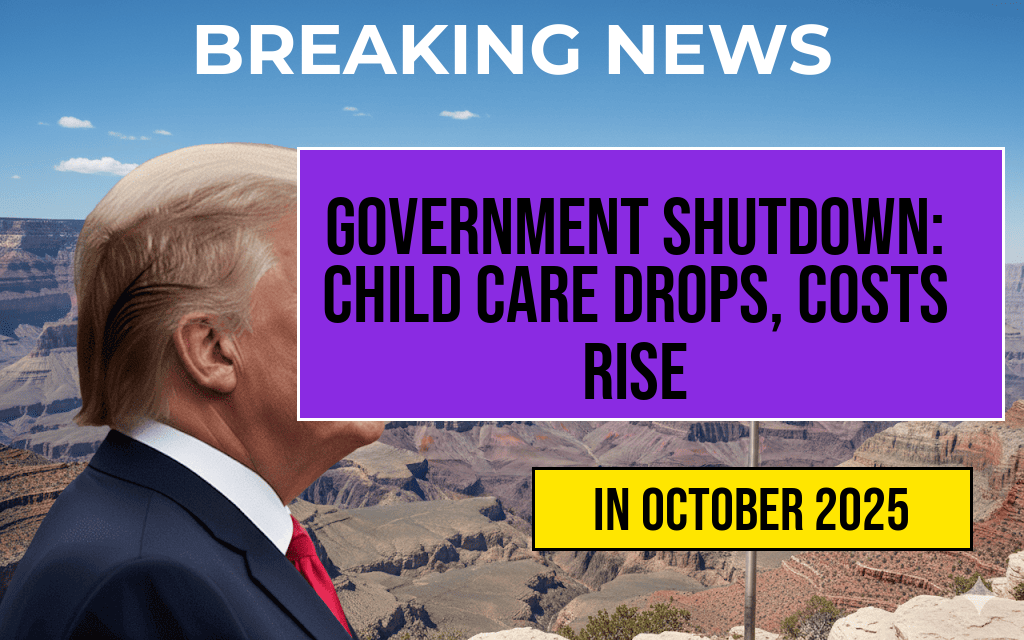The ongoing government shutdown has led to significant disruptions across various sectors, notably affecting child-care services and commuting costs in the Washington, D.C. region. Child-care slots have reportedly fallen to zero, leaving many families scrambling for alternatives. Meanwhile, transportation expenses have surged as federal employees and commuters are forced to navigate a landscape of increased prices and reduced services. As the shutdown drags on, the ripple effects are becoming increasingly evident, highlighting the vulnerability of essential services and the strain on everyday life for residents in the area.
Child-Care Services in Crisis
The shutdown has halted funding for numerous federally funded child-care programs, resulting in a dramatic reduction of available slots. Many parents, especially those working in government jobs or sectors reliant on federal funding, are facing a bleak situation as child-care centers close their doors.
Statistics on Child-Care Availability
- Before the shutdown, the D.C. region offered approximately 10,000 subsidized child-care slots.
- Current reports indicate that available slots have dropped to zero in many areas.
- Parents are now seeking alternative arrangements, often at a higher cost or with longer waiting periods.
This sudden loss of child-care options is particularly challenging for families who rely on these services while working full-time jobs. Many parents are left with no choice but to take unpaid leave or reduce their working hours, leading to financial strains that could last long after the shutdown ends.
Commuting Costs Surge in the D.C. Region
As federal employees and other commuters adjust to the shutdown, commuting costs have spiked. Public transportation systems like Metro have seen an increase in fares, while private transportation options have also raised prices due to heightened demand.
Effects on Transportation Costs
| Commuting Method | Average Cost Before Shutdown | Average Cost After Shutdown |
|---|---|---|
| Metro (One-way fare) | $2.50 | $3.00 |
| Bus Service (One-way fare) | $1.75 | $2.25 |
| Ridesharing (Average trip cost) | $15.00 | $20.00 |
These increased costs are making it harder for families to manage their finances, particularly for those who are already feeling the financial pinch from the lack of child-care services. The price hikes have also led to more congestion on roads as commuters seek to avoid public transit.
Impact on Local Economy
The shutdown’s effects extend beyond individual families to the broader local economy. Businesses that depend on foot traffic, particularly in areas near government offices, are reporting declines in patronage. Restaurants, cafes, and retail stores are feeling the impact as fewer workers are on-site and spending money in the community.
Local Business Responses
- Many businesses are implementing promotions to attract customers.
- Some shops are adjusting hours to accommodate reduced foot traffic.
- Local chambers of commerce are advocating for measures to support affected businesses.
Experts warn that if the shutdown continues, the economic fallout could worsen, leading to job losses and further strain on public services. The situation is particularly dire for small businesses that lack the financial reserves to weather prolonged downturns.
Looking Ahead
As discussions continue in Congress regarding the potential end of the shutdown, families and businesses remain on edge. The situation underscores the fragile interconnectedness of government operations, community services, and the economy. For more information on the effects of the government shutdown and potential solutions, you can visit Forbes or consult resources from Wikipedia.
Frequently Asked Questions
What are the primary effects of the government shutdown on child-care availability?
The government shutdown has led to a dramatic decrease in child-care slots, plummeting to $0 availability. This situation arises because many child-care facilities rely on government funding, which has been halted during the shutdown.
How has the government shutdown impacted commuting costs in the DC region?
Commuting costs in the DC region have surged significantly due to the shutdown. With many federal employees working from home or facing furloughs, public transportation services have been disrupted, causing increased fares and longer travel times.
Are there any resources available for families affected by the loss of child-care slots?
Yes, there are several resources available for families impacted by the loss of child-care slots. Local community organizations and non-profits are offering assistance and information on alternative child-care options during the government shutdown.
What should commuters in the DC region do to manage increased travel costs?
Commuters can manage increased travel costs by exploring alternative commuting methods, such as carpooling, using bike shares, or adjusting their travel times to avoid peak hours, which can help reduce expenses.
How long is the government shutdown expected to last, and what can be done to mitigate its effects?
The duration of the government shutdown is uncertain; however, advocacy efforts are underway to encourage leadership to reach a resolution. In the meantime, families and commuters can seek local support services and community resources to help mitigate the shutdown’s effects.










